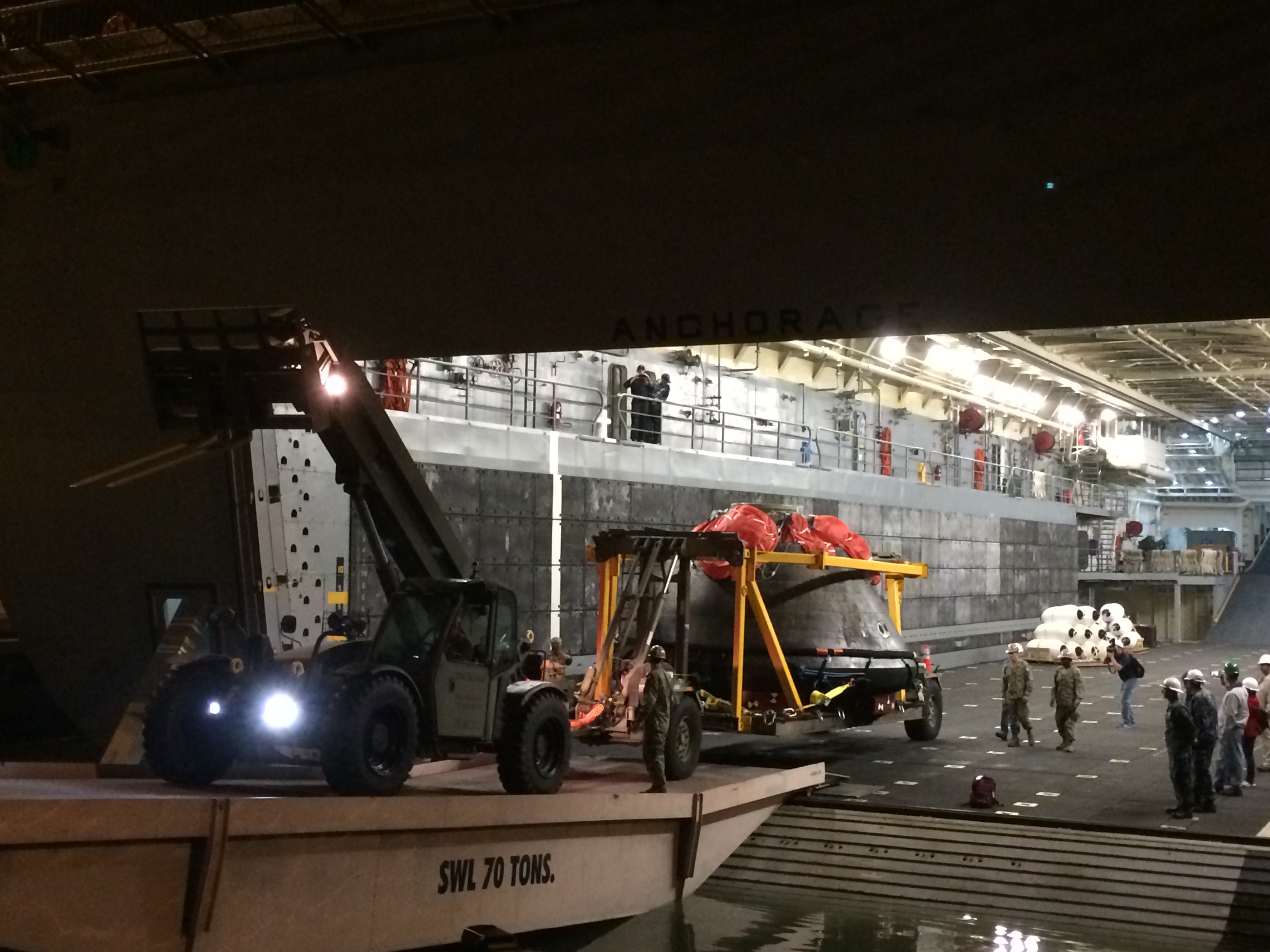
NASA's Orion spacecraft is back on dry land after last week's historic first test flight.
Technicians unloaded the Orion capsule from the USS Anchorage Monday night (Dec. 8) in San Diego, about 600 miles (966 kilometers) from the spot where the U.S. Navy ship retrieved Orion after it splashed down in the Pacific Ocean on Friday (Dec. 5).
Orion will soon be loaded onto a special truck to begin a two-week cross-country trek to NASA's Kennedy Space Center in Florida, where engineers will take the capsule apart to learn more about how its various systems performed during Friday's unmanned space test. [Splashdown! Orion Lands In Pacific Ocean (Video)]
"The 1,200 on-board sensors will provide us an ocean of information about everything from the effects of space radiation on our avionics to the environment inside the crew cabin," Mike Hawes, Lockheed Martin vice president and Orion program manager, said in a statement. (Lockheed Martin builds Orion for NASA.)
"What we learn from this flight will improve Orion’s designs and technology, and help us make future vehicles the best they can be," Hawes added.
During Friday's mission, called Exploration Flight Test-1 (EFT-1), Orion blasted off from Florida's Cape Canaveral Air Force Station and zoomed about 3,600 miles (5,800 kilometers) from Earth before returning home 4.5 hours later at about 20,000 mph (32,000 kph).
EFT-1 was designed to test out Orion's heat shield, avionics and other key systems ahead of future manned flights. NASA is developing Orion to help get astronauts to deep-space destinations, including asteroids and, eventually, Mars.
Get the Space.com Newsletter
Breaking space news, the latest updates on rocket launches, skywatching events and more!
Orion won't reach space again for a few years yet. The capsule's next launch, currently scheduled for 2017 or 2018, will send a different unmanned Orion spacecraft on a weeklong mission around the moon. (The EFT-1 capsule will be readied for a 2018 test of Orion's launch abort system, which is designed to get astronauts clear of danger in the event of a launch emergency.)
Then, if all goes according to plan, Orion will carry astronauts out to a near-Earth asteroid that has been dragged into lunar orbit by a robotic probe. That first manned flight could come as early as 2021, NASA officials say.
EFT-1 used a United Launch Alliance Delta IV Heavy rocket. But future Orion launches will employ NASA's Space Launch System megarocket (SLS), which is currently in development.
When it's ready to go, SLS will be the most powerful rocket ever built, NASA officials say — even more powerful than the agency's famed Saturn V booster, which blasted astronauts toward the moon during the Apollo program in the late 1960s and early 1970s.
Follow Mike Wall on Twitter @michaeldwall and Google+. Follow us @Spacedotcom, Facebook or Google+. Originally published on Space.com.
Join our Space Forums to keep talking space on the latest missions, night sky and more! And if you have a news tip, correction or comment, let us know at: community@space.com.

Michael Wall is a Senior Space Writer with Space.com and joined the team in 2010. He primarily covers exoplanets, spaceflight and military space, but has been known to dabble in the space art beat. His book about the search for alien life, "Out There," was published on Nov. 13, 2018. Before becoming a science writer, Michael worked as a herpetologist and wildlife biologist. He has a Ph.D. in evolutionary biology from the University of Sydney, Australia, a bachelor's degree from the University of Arizona, and a graduate certificate in science writing from the University of California, Santa Cruz. To find out what his latest project is, you can follow Michael on Twitter.









